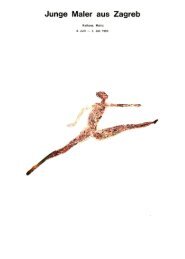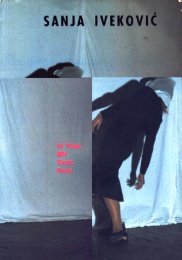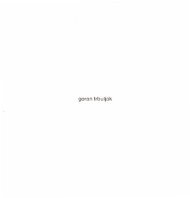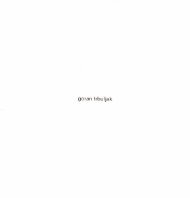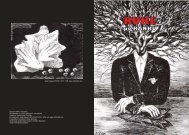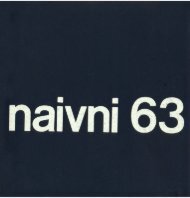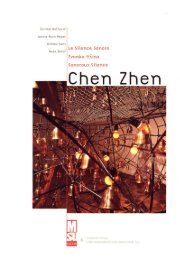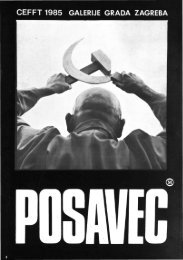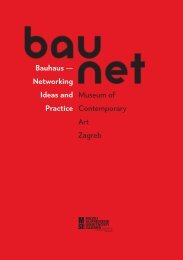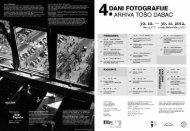The New Art Practice in Yugoslavia, 1966-1978
The New Art Practice in Yugoslavia, 1966-1978
The New Art Practice in Yugoslavia, 1966-1978
- TAGS
- practice
- yugoslavia
- www.msu.hr
Create successful ePaper yourself
Turn your PDF publications into a flip-book with our unique Google optimized e-Paper software.
<strong>in</strong> the contents of the photographic series In Honour of the<br />
Soviet Avant-Garde and <strong>The</strong> Period from 1963 to 1974, and to<br />
the contents of the performance <strong>in</strong> Graz, complet<strong>in</strong>g <strong>in</strong> this way<br />
the group of works <strong>in</strong> which Damnjan expresses his awareness<br />
of the need to state personal views on the position of the<br />
<strong>in</strong>dividual artist and the position of art with<strong>in</strong> the concrete<br />
social and political context of modern reality.<br />
Damnjan's later work Noth<strong>in</strong>g Superfluous <strong>in</strong> the Hurtan Spirit<br />
<strong>in</strong> the photographic medium, cont<strong>in</strong>ues along these same l<strong>in</strong>es.<br />
<strong>The</strong> structure of this work consists of two sets of 16<br />
photographs, the first set show<strong>in</strong>g the artist's face pa<strong>in</strong>ted <strong>in</strong><br />
white, grey or black, differently each time, while <strong>in</strong> the second<br />
set, <strong>in</strong>stead of the pa<strong>in</strong>ted mask, we see the artist's face with<br />
ord<strong>in</strong>al numbers written on his forehead. Besides, <strong>in</strong> both<br />
sets the artist has plaques with numbers from 1 to 16 on his<br />
chest, and all the photographs are distributed on the walls of<br />
the gallery accord<strong>in</strong>g to a def<strong>in</strong>ite pattern of four works with<br />
four photographs each. <strong>The</strong> signs <strong>in</strong>cluded <strong>in</strong> the structure of<br />
the subjects of these photographs (the pa<strong>in</strong>ted face of the<br />
artist, the number on his forehead, the number on his chest,<br />
strictly determ<strong>in</strong>ed lay-out of the photographs) allow for the<br />
possibility of convey<strong>in</strong>g that type of expression <strong>in</strong> which<br />
Damnjan's already characteristic ideological and ethical views<br />
can be recognized. This work was first presented at the<br />
artist's one-man exhibition <strong>in</strong> the Gallery of the Students'<br />
Cultural Centre <strong>in</strong> Belgrade <strong>in</strong> May 1976, and was later exhibited<br />
among the Yugoslav works selected for the Biennial Exhibition<br />
<strong>in</strong> Venice <strong>in</strong> the same year, then at the exhibition ,,Avanguardia<br />
e sperimentazione Le piu avanzate ricerche artistiche<br />
yugoslave» <strong>in</strong> the Galleria civica d'arte moderna <strong>in</strong> Modena<br />
<strong>in</strong> March 1977, and f<strong>in</strong>ally at the <strong>Art</strong>s Center Gallery <strong>in</strong> Genoa<br />
<strong>in</strong> May 1977.<br />
At the April Third Meet<strong>in</strong>g <strong>in</strong> Belgrade 1974 Damnjan handed<br />
around draw<strong>in</strong>gs on offices forms from his series Intervention,<br />
confirm<strong>in</strong>g his authorship by stamp<strong>in</strong>g the works with the<br />
follow<strong>in</strong>g text: R. Damn/an -- Free Work of <strong>Art</strong>. In 1976 he used<br />
a similar way of establishng his authorship by means of a<br />
specially made seal <strong>in</strong> a series of works entitled This is a<br />
work of verified artistic value, first shown at his exhibition <strong>in</strong><br />
Studio 16.:e <strong>in</strong> Tur<strong>in</strong>, <strong>in</strong> January 1977, later presented at the<br />
5th Triennial <strong>in</strong> Belgrade and f<strong>in</strong>ally, <strong>in</strong> November of the same<br />
year, shown at his one-man exhibition <strong>in</strong> Gallery Nova <strong>in</strong><br />
Zagreb. In this work, Damnjan proceeded from the problem of<br />
determ<strong>in</strong><strong>in</strong>g the part played by the artist <strong>in</strong> evaluat<strong>in</strong>g his<br />
own works. He asked himself whether, once he completes his<br />
work, the artist is deprived of the possibility of hav<strong>in</strong>g any<br />
further <strong>in</strong>sight <strong>in</strong>to its fate, and social evaluation. In attempt<strong>in</strong>g<br />
to answer this question by <strong>in</strong>clud<strong>in</strong>g this dilemma <strong>in</strong> the very<br />
structure of his work, Damnjan <strong>in</strong>dicates that the fundamental<br />
value criterion <strong>in</strong> art can be no other than that which, beyond<br />
any sort of a priori standards, is always based on different,<br />
new problems of the concrete artistic practice.<br />
From this <strong>in</strong>sight <strong>in</strong>to Damnjan's views after 1970, we can<br />
conclude that his work has been carried out along two parallel<br />
l<strong>in</strong>es: the first conta<strong>in</strong>ed <strong>in</strong> the series Proposal for a <strong>New</strong><br />
Experience of Colour, Mis<strong>in</strong>formation, Interventions and <strong>in</strong><br />
the two series of primary pa<strong>in</strong>t<strong>in</strong>gs, he focuses on the<br />
problems of the <strong>in</strong>ternal structur<strong>in</strong>g of the language of art,<br />
while <strong>in</strong> the second, conta<strong>in</strong>ed <strong>in</strong> works carried out <strong>in</strong> the<br />
media of photography, video and performance, he wishes to<br />
express his reflections on some of his personal states and on<br />
the general conditions with<strong>in</strong> the concrete social and historical<br />
reality. While the first works are characterized by an objective<br />
and analytical approach, <strong>in</strong> the second, the artist speaks <strong>in</strong><br />
the first person, present<strong>in</strong>g views which are based exclusively<br />
on his subjective experience. In this use of different methods<br />
of expression, there are, however, no contradictions <strong>in</strong><br />
pr<strong>in</strong>ciple: s<strong>in</strong>ce both approaches, the objective and<br />
analytical one, as well as the subjective and synthetic<br />
approach repersent complementary components of a<br />
strategy <strong>in</strong> which, through the artist's practice and behaviour,<br />
rejects the possibility of a passive <strong>in</strong>tegration <strong>in</strong>to a world<br />
of operative and functionalistic existence. In Damnjan's case,<br />
the gestures of this rejection assume at times the form of<br />
chearly conflict<strong>in</strong>g solutions which with time seem to approach<br />
the limits of the ever challeng<strong>in</strong>g, but at the same time<br />
extremely risky self-destruction of the artist.<br />
55



